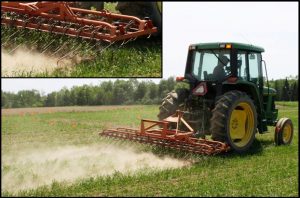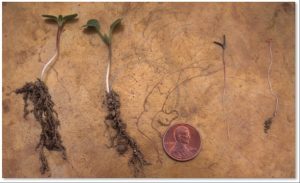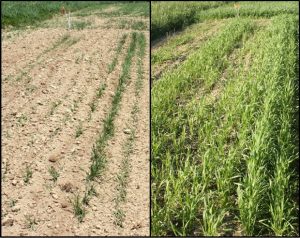Blind Cultivation for Weed Control in Small Grains
By Ellen Mallory, UMaine Extension Sustainable Agriculture Specialist, and Eric Gallandt, UMaine Assoc. Professor of Weed Ecology
Effective weed management in small grains has to start with a competitive crop. For instance, seeding into low, wet, heavy soils is generally a bigger problem for small grains than for weeds. Timely seeding and adequate-to-high seeding rates are important especially if weeds are expected to be a problem. Other practices that can contribute to a multiple-tactic weed management plan include a diverse crop rotation, suitable varieties, high quality seed, undersowing with clover, and avoiding fields with heavy weed pressure. Mechanical weed control in small grains is generally limited to tine harrows or the rotary hoe. For organic growers, once the crop is planted, these so-called “blind” cultivation practices are the only mechanical options for removing weeds from a small grain crop on typical 6- to 7-inch row spacing. Employed properly and under optimal conditions (see below), blind cultivation can be very effective, killing 80 to 90% of weeds.

What it is and how it works
Blind cultivation takes advantage of differences in size and rooting depths of the crop and weeds. A rear-mounted flexible tine harrow or rotary hoe is dragged across the field at relatively high speeds (3 to 6 mph) without regard for the location of rows. The action of the implement dislodges and/or buries very small, shallow-rooted weeds, and uprooted plants then die from desiccation. Flex-tine or spring-tine harrows are the most commonly used implements. As they move across the field, the flexible tines wiggle back and forth and uproot shallow-rooted plants while moving around well-rooted plants and other obstacles (Photo 1). The aggressiveness of a tine-weeder can be adjusted by changing the angle of the tines, down pressure, and tractor speed. Generally, with increasing weed size, harrowing has to be increasingly aggressive to provide a similar degree of control. However, with more aggressive harrowing there is also more direct crop damage and burial.

Blind cultivation should target weed seedlings in the “white thread stage,” such as common lambsquarters that germinate around the time the crop is planted (Photo 2, right). Blind cultivation is less effective against larger-seeded weeds that germinate from greater depths, like wild mustard (Photo 2, left). It is not at all effective against bigger annual or perennial weeds whose root systems are too extensive.
Optimal conditions
- The crop has not yet emerged (pre-emergence) OR has at least 3 to 4 leaves and is well-rooted (post-emergence). These are the two windows of opportunity for blind cultivation. The second window ends just before the crop starts jointing. After this point tractor traffic will damage the emerging seed heads.
- The weeds are in the white thread stage or are just emerging. “White thread” refers to the appearance of the root system. Once the weeds develop multiple fine roots they become much harder to uproot from the soil.
- The soil is dry and friable; and the weather is hot and dry.
- A fine, level seedbed has been prepared with no large clods or clumps of grass. Soil clods and ridges can prevent the tines from completely dislodging weed roots and clods may cover exposed roots protecting them from desiccating.
Other considerations

A common piece of advice for farmers using blind cultivation for the first-time is not to worry about the crop but “just go, go, go and don’t look back.” Often farmers will use slightly deeper planting depths to encourage better rooting of the crop, and slightly higher seeding rates to compensate for any crop stand loss that does occur. However, it is important to realize that it is possible to be too aggressive with blind cultivation or to do it too many times. The crop can be damaged by the direct action of the tines and/or soil burial (see Photo 3). Possible yield lost due to post-emergence harrowing should be weighed against the yield gained by the resulting weed control. Start by harrowing a short section, look to see that you’re getting the action you need to uproot and bury weed seedlings but that you are not completely burying sections of your crop, and then make adjustments to the aggressiveness of the tine harrow accordingly. If conditions are less than optimal for blind cultivation, relying on crop competition may be the best course of action.
For more information on blind cultivation and weed management for small grains, see
- Steel in the Field, edited by Greg Bowman. A pdf version of the complete book can be downloaded for free from the SARE website.
- Chapter 6 — Weed Management, by Jeff Gunsolus, Don Wyse, Kristine Moncada, and Carmen Fernholz, in the Risk Management Guide for Organic Producers. A pdf of each chapter of this book can be downloaded for free at the University of Minnesota Organic Risk Management website.
- Blind Cultivation, by Klaas and Mary-Howell Martens, Lakeview Organic Farm, published on the Rodale Institute website.
